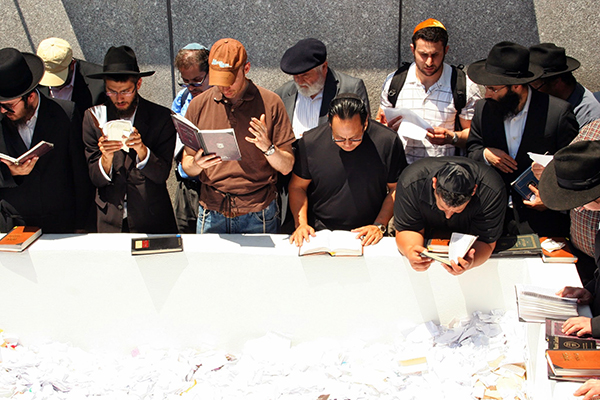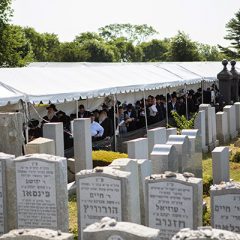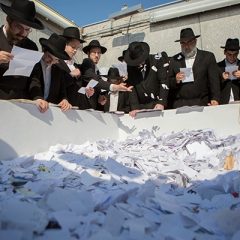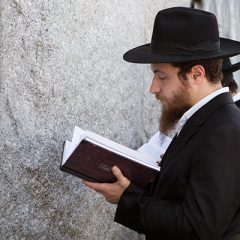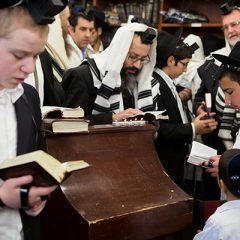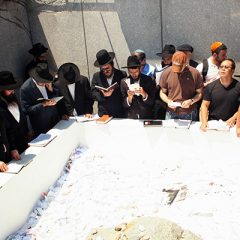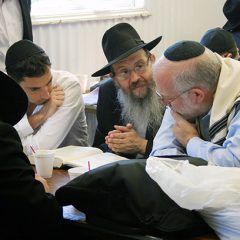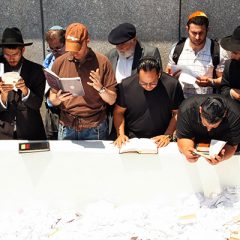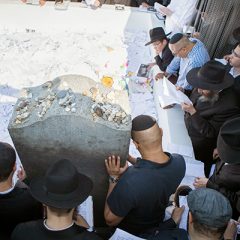(RNS) On any given day, people will make a pilgrimage to Rabbi Menachem Mendel Schneerson’s grave.
A young couple might pray for his blessing before their marriage.
A rabbi might hope for a spark of insight about a theological conundrum.
Politicians — many of them not Jewish — may see it as a gesture of goodwill.
But on July 1, which coincides with the 20th anniversary of Schneerson’s death on the Hebrew calendar, crowds at his grave in Queens, N.Y., swelled. Followers of the black-hat-wearing Chabad-Lubavitch movement came from Brooklyn and New Jersey, but also every continent except Antarctica, to honor the memory of the man they affectionately call “the Rebbe.”
Schneerson, born in 1902 in the Ukraine, fled the persecution of the Nazis, landing in New York City in 1941. From his Brooklyn base, in the years and decades after the Holocaust, he imagined a vibrant revival of his shattered community. Today, Chabad emissaries work worldwide, inviting Jews from the Congo to Hollywood to Shabbat dinners, encouraging them to delve deeply into their faith.
Schneerson believed in optimism, preached kindness and taught that the mission of his followers was to understand their Jewishness and to help others do the same. He reached out warmly to Jews who could not easily relate to Hasidism — the intensely spiritual Jewish movement, rooted in 18th-century Eastern Europe, of which Chabad is a part.
On the 20th anniversary of his death, many Jews outside his circle felt moved to remark on Schneerson’s influence. Wrote Rabbi Tzvi Hersh Weinreb, executive vice president emeritus of the Orthodox Union: “The Rebbe was not just a rebbe for Chabad Chassidim. He was, and remains, a rebbe for us all.”
A fraction of his followers believe that Schneerson may be the Messiah. But that view is not endorsed by the leadership of Chabad-Lubavitch. As Joseph Telushkin writes in “Rebbe,” one of several books out on Schneerson this year, the mainstream Chabad view is that the Rebbe felt it was pointless to try to figure out who the Messiah will be: “They recognize that they have no way of knowing and it’s all simply up to God.”
MG END MARKOE
(Click on any photo to begin the slideshow.)
- Visitors wait in line at the gravesite of the late Lubavitcher Rebbe, Rabbi Menachem Mendel Schneerson, on the 20th anniversary of the Rebbe’s passing, July 1, 2014, at Old Montefiore Cemetery in the Queens borough of New York.
- Visitors pray at the gravesite of the Lubavitcher Rebbe, Rabbi Menachem Mendel Schneerson, on June 29, 2014, at the Old Montefiore Cemetery in the Queens borough of New York. July 1 marked the 20th anniversary of Rebbe’s passing.
- A man prays at the gravesite of the Lubavitcher Rebbe, Rabbi Menachem Mendel Schneerson, on June 29, 2014, at the Old Montefiore Cemetery in the Queens borough of New York. July 1 marked the 20th anniversary of Rebbe’s passing.
- Visitors pray at a synagogue adjacent to the gravesite of the late Lubavitcher Rebbe, Rabbi Menachem M. Schneerson, on June 29, 2014, at the Old Montefiore Cemetery in the Queens borough of New York. July 1 marked the 20th anniversary of Rebbe’s passing.
- Visitors pray at the gravesite of the Lubavitcher Rebbe, Rabbi Menachem Mendel Schneerson, on June 29, 2014, at the Old Montefiore Cemetery in the Queens borough of New York. July 1 marked the 20th anniversary of Rebbe’s passing.
- Visitors study a hasidic text in a synagogue adjacent to the Lubavitcher Rebbe, Rabbi Menachem M. Schneerson’s gravesite, on June 29, 2014, at the Old Montefiore Cemetery in the Queens borough of New York. Tuesday (July 1) marked the 20th anniversary of Rebbe’s passing.
- Visitors pray at the gravesite of the Lubavitcher Rebbe, Rabbi Menachem Mendel Schneerson, on June 29, 2014, at the Old Montefiore Cemetery in the Queens borough of New York. July 1 marked the 20th anniversary of Rebbe’s passing.
- Visitors pray at the gravesite of the Lubavitcher Rebbe, Rabbi Menachem Mendel Schneerson, on June 29, 2014, at the Old Montefiore Cemetery in the Queens borough of New York. July 1 marked the 20th anniversary of Rebbe’s passing.
